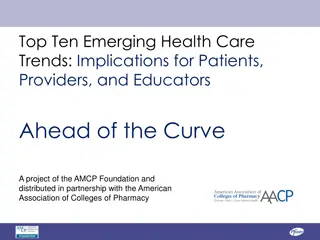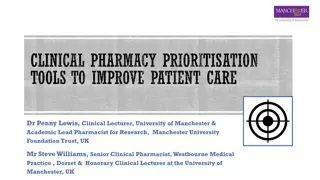Specialty Pharmacy Service Expansion Business Case Preparation
This document equips health-system pharmacy team members with essential information and questions to build a solid business case for expanding specialty pharmacy services. It covers aspects like financial costs, marketing strategies, service considerations, and model planning to enhance success in presenting to leadership. The resource addresses operational, clinical, and regulatory factors, emphasizing the importance of thorough planning and leveraging existing resources for a successful specialty pharmacy program implementation.
Download Presentation

Please find below an Image/Link to download the presentation.
The content on the website is provided AS IS for your information and personal use only. It may not be sold, licensed, or shared on other websites without obtaining consent from the author. Download presentation by click this link. If you encounter any issues during the download, it is possible that the publisher has removed the file from their server.
E N D
Presentation Transcript
BUSINESS DEVELOPMENT MARKETING POWERPOINT This document prepares health-system pharmacy team members for building a viable business case for specialty pharmacy service expansion. Members are provided questions and information to consider for the justification of services. Suggestions to improve odds of success and delivery of information to leadership are also included.
BUSINESS DEVELOPMENT MARKETING POWERPOINT
LEARNING OBJECTIVES Understand the financial and labor costs associated with starting or growing a specialty pharmacy program Costs ROI Business plan Space and infrastructure considerations 1. a. b. c. d. Outline strategies to market your specialty pharmacy proposal to the C-Suite and/or leadership Internal analysis Service model plan Benefits of service (economic, clinical, humanistic) Challenges Making the sell (presentation pearls) 2. a. b. c. d. e.
Understand the financial and labor costs associated with starting or growing a specialty pharmacy program
SERVICE CONSIDERATIONS Operations/Distribution Model Clinical Support Systems integration Clinical monitoring Formulary management Accreditation requirements Side effect mitigation Medication access Regulatory requirements Outcomes measurements Education environment In-person vs. call center Provider relations and internal marketing Supply chain Storage Delivery logistics Automation Scalability Marketing Physical environment of pharmacy Support services location Call staff Data reporting and IT Mail-out services Inventory GPO vs. WAC vs. 340B management Compliance and accreditation
WHAT WILL YOUR MODEL LOOK LIKE? Questions necessary to answer: How will pharmacists provide counseling and clinical care? What specialty medications will be dispensed? What physicians will be engaged? Will you market internally and externally (payers & employers)? What current resources exist? (space, pharmacy staff, institutional) Will only specialty medications be dispensed? Will the service be initiated with specific accreditation(s) in mind? Will only health-system patients and/or employees be served? Is 340B compliance relevant? Will any core or ancillary services need to be contracted out?
SERVICE PROVISION Appeals More advanced service levels lead to increased Drug access Payer access Cost Labor needs Copay Assistance Outcomes reporting Clinic-embedded pharmacist Compounding Prior authorization Mail-order services Data analytics and reporting Dispensing and sales Pharmacy operations Benefits investigation Prescription verification
COST CONSIDERATIONS Initial investment of equipment and infrastructure Personnel / labor Space Inventory Technology Other
COSTS - LABOR Varies by geographic region and job market Total base cost includes salary + fringe benefits Pharmacist (divided among distributive and clinical processes) $125,000 - $160,000+ / FTE Technician $40,000 - $60,000+ / FTE Management Varies depending on other responsibilities split within department Support staff (IT, data analyst, legal, compliance, etc.) Varies Consider increased time per dispensed prescription vs. standard retail prescription One specialty prescription could require five touchpoints vs. two for standard prescription May need to adjust productivity metrics Adjustments to salary and/or annual cost (optional) Continuing education Certification Conferences & travel
COSTS - SPACE Baseline requirements for specialty pharmacy: Space for inventory storage, product verification, and dispensing Technology (computers, dispensing machines) Furnishings Drug & supply storage Shelving Refrigerator +/- Freezers (cold packs for shipping) Higher % of refrigerated products than standard pharmacy Equipment required by contract, regulations, and/or state law Temperature & humidity monitoring, locked cabinets, cameras Other space considerations: In-person counseling room If mail-out service present: Packing area Storage for packaging materials Personnel (Offices, item storage, call center) Leasing: Obtain quotes for cost / sq feet, varies by geographic region and market
COSTS - INVENTORY AND DISPENSING May exceed $10,000 per 30 day supply per medication Need to consider continued overhead with increasing growth May require strict storage requirements (refrigerated is most common) Due to cost, medication waste much more impactful Ancillary supplies Sharps containers ($10 - $50 / unit) Medication supplies (gauze, bandages, syringes) Nebulizers, compressors, atomizers Mail-out supplies Box Associated packaging Ice packs
COSTS - TECHNOLOGY Hardware Computer Prescription scanners Printer (combo w/fax and/or e-mail support) Dispensing automation Phone-system (preference for call monitoring system) Registers / Point of sale system Software EHR add-on modules Facilitates accreditation documentation requirements Can be commercial or internally developed Adjudication services Medication assistance and copay assistance Prior authorization integration 340B auditing (if relevant)
COSTS - OTHER Ongoing Non-340B eligible locations / providers Audits Accreditation Licensing fees Insurance Staff dedicated to information technology and/or outcomes reporting Legal fees Contracted services Data validation Specialty Pharmacy Distribution Network participation Reimbursement modifiers DIR fees Contracted rates Payer mix 340B eligible patients and locations Drug inflation
GROWTH AND FINANCIAL SUSTAINABILITY Costs Initial Operational Prescription volume anticipated Initial capture rate / market penetration Anticipated growth over time New drugs / indications New patients / throughput New providers / therapeutic areas Anticipated decline Use of curative agents with a limited population (Hep C)
GROWTH AND FINANCIAL SUSTAINABILITY Financials Revenue (revenue / Rx) (total revenue) Gross margin (margin / Rx) (total gross margin) Review contract or historical reimbursement Understand acquisition cost Net income Scaling to growth Plan for metrics to increase staff with increased volume RPh or tech / patients or Rx dispensed 3 - 5 year plan - How will you grow? Expected ROI by disease state, per staff member, total labor costs Utilize projected metrics above to calculate the following: Breakeven: (initial + operational costs = net income) Return on investment at different time periods ((value - cost / cost)) 6 months, 1 year, 2 year, 5 year
FURTHER STRATEGIC CONSIDERATIONS AND FINANCIAL IMPACT Decreased reimbursement Decreased contracted payments Unfavorable payer mix Drug mix Variance of revenue and gross margin per drug & disease state Transition of standard of care from one agent to another Ability to serve population Global trends in medication prescribing Declining Hepatitis C prescribing as higher % of population cured % of business / market penetration excluded by payers due to Accreditation requirements Contracting with other specialty pharmacies Mail-order with surrounding and outside state licenses Ability to provide ancillary services (nursing or other) Site of care Complexity of medically billed specialty medications dispensed from pharmacy
Sample Draft Cost Template Labor cost (with fringe benefit) Space Lease / Purchase Operational expense Position FTE Cost Total Location Sq ft Cost Total Expense # Cost Total Pharmacist Dispensing area Inventory Overhead Technician Drug storage Licenses / Software Management Supply storage Accreditation & third party fees Support staff 1 Refrigerator storage DIR Fees Support staff 2 Office / computer Drug waste Overtime Desks Marketing & supplies Total cost Total cost Total cost
TIME IS MONEY - COMMON SPECIALTY TIME UTILIZERS Development Build infrastructure (space, staffing, accreditation) Relationship building (health-system and external) Policies and procedures Contracting Maintenance Accreditation compliance Competencies Quality assurance and improvement Medication safety Clinical care & longitudinal patient management Dispense & mail-out coordination Efficiencies Growth Monitoring for and adjusting to new drugs and services Pharmacist clinic-embedded strategy and adoption of best practice Opportunity cost
Outline strategies to market your specialty pharmacy proposal to the C-Suite and/or leadership
ORGANIZATIONAL ENGAGEMENT Develop internal team Pharmacy specialists Pharmacy leadership Identify multi-disciplinary champions Physician and nursing leadership Executive Regular touch points Pharmacy leadership Finance Informatics Clinical areas
SELLING TO LEADERSHIP AND/OR THE C-SUITE Develop a strategic plan and associated financials Be able to articulate a SWOT analysis or business plan Collaborate with supervisor to address gaps and deficiencies Multiple times if necessary Have a clear and succinct plan to address the following Benefits to patients Benefits to health-system Opportunity for revenue generation Timeline for benefits to be realized Limitations to projections Sensitivity analysis Answering the question: Why should we price funding vs. other health-system initiatives
BENEFITS FOR HEALTH-SYSTEM Economic Clinical Humanistic
ECONOMIC Revenue generating opportunity Breakeven in short-time period (relatively speaking) Financially viable AND ability to improve care (win-win) Decrease fragmentation of care Improve brand penetration Ability to assist other departments and health-system needs Cost-savings with inpatient collaboration (formulary management, biosimilars, ultra-high cost) Improved turnaround time for prescription dispense 340B contracting shared resources (drug access/ data analysts) Drug access benefits entire system Financial assistance (medication assistance, copay, foundation, manufacturer, charity care) Cost avoidance to organization
CLINICAL OUTCOMES Ability to obtain and improve outcomes for: Adherence Persistence Vaccinations Lab monitoring (adherence, follow-up) Medication effectiveness Cure rates Flare frequency and potential hospitalization Side effect management Care coordination Primary care and/or specialist referral
HUMANISTIC Patient satisfaction Pharmacy services Clinic service line Health-system Provider satisfaction Clinic service line satisfaction Ability to capture patient reported outcomes
BRINGING IT ALL TOGETHER Market trending to continued and increasing relevance of specialty medications Starting and growing a specialty pharmacy service line is labor and resource intensive Organizational engagement is integral to success A patient centered approach is necessary Opportunity to optimize clinical outcomes, improve patient experience, AND generate revenue With current market, breakeven and ROI can be achieved relatively quickly























